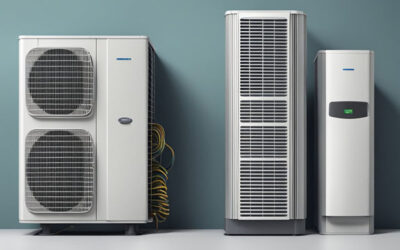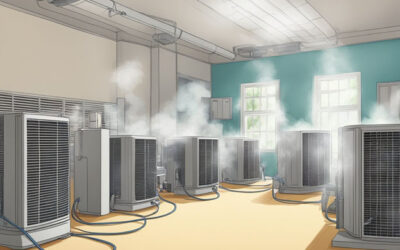Indoor air quality is an important aspect of any building, whether it be a home or a workplace. It can affect the health and well-being of those who occupy the space, as well as impact the productivity and comfort levels of individuals. While many people may assume that maintaining good indoor air quality is solely the responsibility of their HVAC system, there are actually a variety of factors that contribute to the overall quality of the air.
One of the main contributors to indoor air quality is the presence of pollutants and contaminants. These can come from a variety of sources, including cleaning products, building materials, and even outdoor air pollution that seeps indoors. Additionally, the presence of moisture and humidity can lead to the growth of mold and mildew, which can have negative impacts on air quality. It is important to address these factors in order to maintain a healthy and comfortable indoor environment.
Overall, indoor air quality is a multifaceted issue that requires attention and care. While HVAC systems play an important role in maintaining air quality, there are many other factors to consider. By addressing pollutants, humidity levels, and other contributing factors, individuals can ensure that they are breathing clean and healthy air.
Understanding Indoor Air Quality
Indoor air quality (IAQ) refers to the quality of the air inside a building. It is affected by various factors such as temperature, humidity, ventilation, and the presence of pollutants. Poor IAQ can cause health problems such as headaches, fatigue, and respiratory issues. Therefore, it is important to understand the factors that affect IAQ and how to maintain good IAQ.
One of the key factors that affect IAQ is ventilation. Proper ventilation ensures that fresh air is brought into the building and stale air is expelled. This helps to dilute the concentration of pollutants in the air. Inadequate ventilation can cause a buildup of pollutants, leading to poor IAQ.
Another factor that affects IAQ is humidity. High humidity levels can promote the growth of mold and bacteria, which can cause respiratory problems. Low humidity levels can lead to dry skin and respiratory irritation. The ideal range of humidity for IAQ is between 30% and 60%.
Pollutants can also affect IAQ. These can come from various sources such as building materials, cleaning products, and outdoor air pollution. Common indoor pollutants include volatile organic compounds (VOCs), carbon monoxide, and particulate matter. Exposure to these pollutants can cause health problems, especially in vulnerable populations such as children and the elderly.
In summary, IAQ is an important aspect of building health and should not be overlooked. Proper ventilation, humidity control, and pollutant management are key factors in maintaining good IAQ.
Components of Indoor Air Quality
Indoor air quality (IAQ) refers to the quality of the air inside a building, which can have a significant impact on the health and well-being of its occupants. IAQ is influenced by several factors, including pollutants and particulates, humidity levels, ventilation, and airflow.
Pollutants and Particulates
Pollutants and particulates are microscopic particles and gases that can be harmful to human health. These can include dust, pet dander, mold spores, and volatile organic compounds (VOCs) emitted by cleaning products and building materials. Exposure to these pollutants and particulates can cause respiratory problems, allergies, and other health issues.
To improve IAQ, it is important to identify and eliminate sources of pollutants and particulates. This can be achieved through regular cleaning, proper ventilation, and the use of air purifiers and filtration systems.
Humidity Levels
Humidity levels can also have a significant impact on IAQ. High humidity can lead to mold growth and other moisture-related issues, while low humidity can cause dry skin, respiratory problems, and other health issues.
To maintain optimal humidity levels, it is recommended to keep indoor humidity levels between 30-50%. This can be achieved through the use of dehumidifiers and humidifiers, as well as proper ventilation and air circulation.
Ventilation and Airflow
Ventilation and airflow play a crucial role in maintaining IAQ. Proper ventilation helps to remove pollutants and particulates from indoor air, while also regulating temperature and humidity levels.
To improve ventilation and airflow, it is important to ensure that HVAC systems are properly maintained and functioning efficiently. This can include regular filter changes, duct cleaning, and the use of air purifiers and ventilation systems.
Overall, understanding the components of IAQ is essential for maintaining a healthy and comfortable indoor environment. By addressing pollutants and particulates, humidity levels, and ventilation and airflow, building occupants can enjoy improved IAQ and better overall health and well-being.
Role of HVAC Systems in Air Quality
Indoor air quality is a crucial aspect of maintaining a healthy and comfortable environment in any building. HVAC (heating, ventilation, and air conditioning) systems play a vital role in ensuring good air quality. They not only regulate the temperature but also filter out pollutants and maintain proper humidity levels. In this section, we will discuss the role of HVAC systems in air quality.
Filtration Systems
One of the primary functions of HVAC systems is to filter out pollutants from the air. HVAC filters capture dust, pollen, and other particles that can cause allergies and respiratory problems. There are different types of filters available, such as fiberglass, pleated, and high-efficiency particulate air (HEPA) filters. HEPA filters are the most effective in capturing small particles and are recommended for people with allergies or asthma.
Regular Maintenance and Upkeep
To ensure that HVAC systems continue to function properly, regular maintenance and upkeep are essential. Dirty filters can reduce the efficiency of the system and lead to poor air quality. Regular cleaning and replacement of filters should be done to ensure that the HVAC system is functioning optimally.
In addition to filter maintenance, other components of the HVAC system, such as coils and ducts, should also be cleaned regularly. Dirty coils can reduce the efficiency of the system, while dirty ducts can circulate pollutants throughout the building.
In conclusion, HVAC systems play a crucial role in maintaining good indoor air quality. Filtration systems and regular maintenance and upkeep are essential to ensure that HVAC systems function optimally and provide clean and healthy air.
Beyond HVAC: Complementary Approaches
Indoor air quality can be improved by more than just relying on HVAC systems. There are several complementary approaches that can be used to enhance the quality of indoor air.
Indoor Plants for Air Purification
Indoor plants can be used to improve indoor air quality by removing pollutants from the air. According to a study by NASA, certain plants such as spider plants, peace lilies, and Boston ferns can effectively remove pollutants like formaldehyde, benzene, and trichloroethylene from the air.
Not only do indoor plants improve air quality, but they also add aesthetic value to indoor spaces. It is important to note that some plants can be toxic to pets, so it is important to research which plants are safe to have around pets.
Natural Ventilation Strategies
Natural ventilation strategies can be used to improve indoor air quality by allowing fresh air to circulate through indoor spaces. This can be achieved by opening windows and doors or using exhaust fans to remove stale air and bring in fresh air.
It is important to note that natural ventilation may not be effective in areas with high levels of outdoor pollution or allergens. Additionally, it may not be practical in areas with extreme temperatures or high humidity levels.
Air Purifiers and Cleaners
Air purifiers and cleaners can be used to remove pollutants from indoor air. These devices work by using filters to trap pollutants like dust, pollen, and pet dander. Some air purifiers also use UV-C light to kill bacteria and viruses.
It is important to note that air purifiers and cleaners should be used in conjunction with other approaches to improve indoor air quality. Additionally, it is important to regularly clean and replace filters to ensure that the device is working effectively.
In conclusion, there are several complementary approaches that can be used to improve indoor air quality beyond relying solely on HVAC systems. By using indoor plants, natural ventilation strategies, and air purifiers and cleaners, indoor air quality can be significantly improved.
Measuring and Monitoring Air Quality
Indoor air quality (IAQ) can have a significant impact on human health and overall well-being. To ensure that IAQ is at an acceptable level, it is important to measure and monitor air quality regularly. There are several types of sensors available that can help monitor IAQ.
Carbon Dioxide Sensors
Carbon dioxide (CO2) sensors are used to measure the concentration of CO2 in the air. High levels of CO2 can lead to fatigue, headaches, and decreased cognitive function. CO2 sensors can be used to monitor the air quality in classrooms, offices, and other indoor spaces where people spend a significant amount of time.
Particulate Matter Detectors
Particulate matter (PM) detectors are used to measure the concentration of small particles in the air. These particles can come from a variety of sources, including dust, pollen, and smoke. High levels of PM can lead to respiratory problems, especially in individuals with pre-existing conditions such as asthma. PM detectors can be used to monitor the air quality in homes, offices, and other indoor spaces.
Volatile Organic Compounds (VOC) Sensors
Volatile organic compounds (VOCs) are chemicals that are released into the air from a variety of sources, including cleaning products, paints, and building materials. High levels of VOCs can lead to headaches, nausea, and other health problems. VOC sensors can be used to monitor the air quality in homes, offices, and other indoor spaces.
Regular monitoring of IAQ can help ensure that the air in indoor spaces is safe and healthy for occupants. Using sensors such as CO2 sensors, PM detectors, and VOC sensors can help identify potential problems and allow for corrective action to be taken if necessary.
Health Impacts of Indoor Air Quality
Indoor air quality can have a significant impact on health. Poor indoor air quality can cause a range of health problems, from minor irritations to serious illnesses. The following are some of the health impacts of indoor air quality:
Respiratory Problems
Poor indoor air quality can cause or worsen respiratory problems such as asthma, allergies, and chronic obstructive pulmonary disease (COPD). Dust, mold, and other airborne particles can trigger respiratory problems, making it difficult to breathe and causing wheezing, coughing, and other symptoms.
Headaches and Fatigue
Poor indoor air quality can also cause headaches, fatigue, and other symptoms of sick building syndrome. Sick building syndrome is a condition that occurs when people experience symptoms such as headaches, fatigue, and respiratory problems when they are in a particular building. Sick building syndrome is often caused by poor indoor air quality.
Eye, Nose, and Throat Irritation
Poor indoor air quality can cause irritation of the eyes, nose, and throat. This can cause symptoms such as red, itchy eyes, a runny or stuffy nose, and a sore throat. These symptoms can be caused by a range of airborne particles, including dust, mold, and other pollutants.
Cardiovascular Problems
Poor indoor air quality can also have an impact on cardiovascular health. Exposure to pollutants such as carbon monoxide and nitrogen dioxide can increase the risk of cardiovascular problems such as heart attack and stroke.
In conclusion, the health impacts of indoor air quality can be significant. Poor indoor air quality can cause a range of health problems, from minor irritations to serious illnesses. It is important to take steps to improve indoor air quality to protect the health of those who live and work in buildings.
Best Practices for Improving Indoor Air Quality
Improving indoor air quality is essential for maintaining a healthy living environment. Here are some best practices that can help improve the indoor air quality:
1. Regular Cleaning
Regular cleaning is one of the most effective ways to improve indoor air quality. Dust and dirt can accumulate in carpets, furniture, and other surfaces, leading to poor air quality. It is recommended to vacuum carpets and upholstery regularly and to dust surfaces with a damp cloth to prevent the spread of dust particles.
2. Proper Ventilation
Proper ventilation is crucial for maintaining good indoor air quality. It helps to remove pollutants and moisture from the air, preventing the buildup of harmful substances. It is recommended to open windows and doors to allow fresh air to circulate, especially when using cleaning products or cooking.
3. Use of Air Purifiers
Air purifiers can help to remove pollutants from the air, improving indoor air quality. They work by filtering out particles and contaminants, such as dust, pollen, and smoke. It is recommended to choose an air purifier with a HEPA filter, which can capture particles as small as 0.3 microns.
4. Proper Maintenance of HVAC Systems
Proper maintenance of HVAC systems is essential for maintaining good indoor air quality. Dirty filters and ducts can lead to poor air quality and can even cause health problems. It is recommended to change air filters regularly and to have HVAC systems inspected and cleaned by a professional.
5. Avoidance of Harmful Chemicals
Harmful chemicals, such as cleaning products and pesticides, can release harmful pollutants into the air, leading to poor indoor air quality. It is recommended to use natural cleaning products and to avoid the use of pesticides whenever possible.
By following these best practices, individuals can improve indoor air quality and maintain a healthy living environment.
Regulations and Standards for Indoor Air Quality
Indoor air quality is a crucial aspect of maintaining a healthy and safe living or working environment. As such, there are various regulations and standards in place to ensure that indoor air quality is maintained at acceptable levels.
The Environmental Protection Agency (EPA) sets standards for indoor air quality in the United States. These standards are based on scientific evidence and are designed to protect public health. The EPA has established guidelines for common indoor air pollutants, including radon, carbon monoxide, particulate matter, and volatile organic compounds.
In addition to federal regulations, there are also state and local regulations that govern indoor air quality. These regulations can vary depending on the location and the type of building. For example, some states have specific regulations for schools and childcare facilities.
There are also industry standards that provide guidance on maintaining indoor air quality. The American Society of Heating, Refrigerating and Air-Conditioning Engineers (ASHRAE) has developed standards for ventilation, air quality, and energy efficiency in buildings. These standards are widely recognized and used in the HVAC industry.
Building owners and managers are responsible for ensuring that their buildings meet these regulations and standards. Regular maintenance and inspections of HVAC systems and ventilation are crucial to maintaining good indoor air quality. In addition, building occupants can take steps to improve indoor air quality, such as using air purifiers, avoiding smoking indoors, and using natural cleaning products.
Overall, regulations and standards for indoor air quality are an important aspect of maintaining a healthy and safe indoor environment. It is crucial for building owners, managers, and occupants to be aware of these regulations and take steps to ensure compliance.





0 Comments